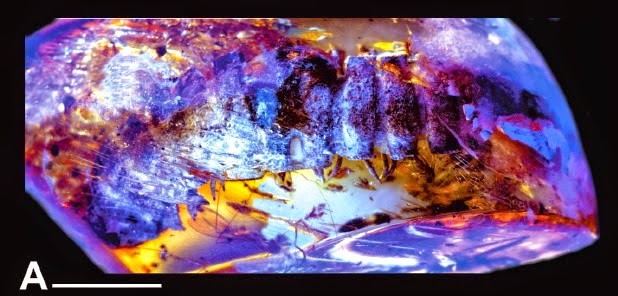Mushrooms of the genus Agaricus
are well studied in temperate regions, where there are over 400 species divided
into eight groups, including many commercially important medical species. The
group is also found in the tropics, where it is likely to be much more diverse,
although it is poorly studied here. Many tropical Agaricus Mushrooms are known not to fit into the traditional eight
divisions, suggesting that fitting these Fungi into the group’s taxonomy will
require considerable revision of the genus.
In a paper published in the journal Phytotaxa on 14 January 2015, a
team of mycologists led by Jie Chen of the State key laboratory of Mycology at
the Institute of Microbiology of the Chinese Academy of Sciences and the Instituteof Excellence in Fungal Research and School of Science at Mae Fah LuangUniversity present a study of tropical members of the section Brunneopicti of the genus Agaricus in which four new species are
described, all from Thailand.
The first new species described is named Agaricus niveogranulatus, meaning ‘white granules’, in reference to
the colour and texture of the squamules (scales on the upper surface of the
Mushroom). The Mushrooms of this fungus are 10-16 cm in diameter, starting out
as hemisphere, but becoming flatter as they mature. The gills start out white,
turning pink as they mature, then orange-brown, then brown, then dark brown.
The flesh of the Mushroom is white, and gives of a phenol-like smell. These
Mushrooms were found in Dipterocarp forests, Bamboo woodland and grassland, as
well as in cultivated parks and gardens. It was found in Chiang Rai and Chiang
Mai Provinces of Thailand.
Section viewof Agaricus
niveogranulatus in laboratory. Scale bar is 20 mm. Chen et al. (2015).
The second new species described is named Agaricus brunneosquamulosus, meaning ‘brown squamules’, a reference
to the colour of the scales on the upper surface of the Mushroom. The Mushrooms
of this species reach 3-6 cm in diameter, starting out convex then flattening
as they age. The gills are pinkish to grey, and turn dark brown with age. The
flesh of the Mushroom is white, but turns pink after being cut, and emits a
phenol-like smell. The species was found growing in grassland and gardens in Chiang
Mai Province, Thailand.
Specimen of Agaricus
brunneosquamulosus growing in the wild. Scale bar is 10 mm. Chen et al. (2015).
The third new species is named Agaricus
sordidocarpus, in reference to the dirty appearance of the Mushrooms, which
have fibrous squamules and develop a grey tint after rain. The Mushrooms grow
up to 4 cm in diameter, grey-brown in colour and convex with a flattened top.
The gills are pink or brownish-grey, turning darker as they age. The flesh of
the Mushrooms is firm and white, and emits a phenol-like smell. The species was
found growing in the grounds of Chiang Mai University.
Brownish gray squamules on the upper surface of an Agaricus sordidocarpusMushroom. Scale
bar is 10 mm. Chen et al. (2015).
The final new species is named Agaricus
toluenolens, in reference to the toluene-like odour the Mushrooms produce
when bruised (expand). The Mushrooms are 3-6 cm in diameter and convex to flat
in shape, with brownish-grey squamules. The gills are pink to brownish-grey,
turning browner as they age. The flesh is firm and white, but with a strong,
unpleasant smell. The Mushroom was found growing on grass in Chang Mai
Province.
Mushroom of Agaricus
toluenolens. Scale bar is 10 mm. Chen et
al. (2015).
See also…
 Two new species of Coral Fungi from the Ozark region of Arkansas. Coral Fungi of the genus Ramaria
have been extensively studied in the temperate rainforests of the American
Pacific Northwest, and to a lesser extent in the forests of America’s Eastern
Seaboard, but are...
Two new species of Coral Fungi from the Ozark region of Arkansas. Coral Fungi of the genus Ramaria
have been extensively studied in the temperate rainforests of the American
Pacific Northwest, and to a lesser extent in the forests of America’s Eastern
Seaboard, but are...
Earthstars (Geastrales) are distinctive Macro-fungi (fungi that produce
large fruiting bodies) found in...
Follow Sciency Thoughts on Facebook.











